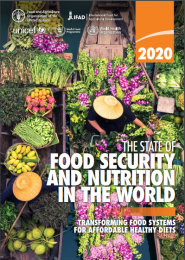The State of Food Security and Nutrition in the World 2020: Transforming food systems for affordable healthy diets

Review / Resumen:
Updates for many countries have made it possible to estimate hunger in the world with greater accuracy this year. In particular, newly accessible data enabled the revision of the entire series of undernourishment estimates for China back to 2000, resulting in a substantial downward shift of the series of the number of undernourished in the world. Nevertheless, the revision confirms the trend reported in past editions: the number of people affected by hunger globally has been slowly on the rise since 2014. The report also shows that the burden of malnutrition in all its forms continues to be a challenge. There has been some progress for child stunting, low birthweight and exclusive breastfeeding, but at a pace that is still too slow. Childhood overweight is not improving and adult obesity is on the rise in all regions.
The report complements the usual assessment of food security and nutrition with projections of what the world may look like in 2030, if trends of the last decade continue. Projections show that the world is not on track to achieve Zero Hunger by 2030 and, despite some progress, most indicators are also not on track to meet global nutrition targets. The food security and nutritional status of the most vulnerable population groups is likely to deteriorate further due to the health and socio economic impacts of the COVID-19 pandemic.
The report puts a spotlight on diet quality as a critical link between food security and nutrition. Meeting SDG 2 targets will only be possible if people have enough food to eat and if what they are eating is nutritious and affordable. The report also introduces new analysis of the cost and affordability of healthy diets around the world, by region and in different development contexts. It presents valuations of the health and climate-change costs associated with current food consumption patterns, as well as the potential cost savings if food consumption patterns were to shift towards healthy diets that include sustainability considerations. The report then concludes with a discussion of the policies and strategies to transform food systems to ensure affordable healthy diets, as part of the required efforts to end both hunger and all forms of malnutrition.
The following complementary information is available:
Cite this content as:
FAO, IFAD, UNICEF, WFP and WHO. 2020. The State of Food Security and Nutrition in the World 2020. Transforming food systems for affordable healthy diets. Rome, FAO.
